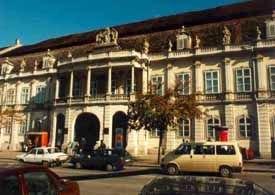 | Founded in 1951, the National Museum of Art in Cluj-Napoca has a rich and varied collection of Romanian and European art, mainly painting, graphical works and decorative art, from the 15th - 20th century, surely worth a visit even if you're not an art fanatic. At start, the first collections of the museum were older ones : some of the furniture, paintings and unusual objects from the Ardeal Museum and most of the collection known as "Virgil Cioflec Art Gallery". |
Although unknown to larger audiences, Virgil Cioflec (1876 - 1948) was a major name in the history of Romanian art, as a collector and especially as the author of two substantial monographies, dedicate to Stefan Luchian and Nicolae Grigorescu. He also published several art history articles in magazines and newspapers, being considered one of the most tallented critics and art historians of his time. His best remembered gesture was by all means the donation of his Romanian art collection to the University in Cluj-Napoca, a generous idea that practically laid down the bases for the future Art Museum. The Virgil Cioflec Art Gallery was opened to the public in 1933, and it was here that we can find the origins of today's prestigious institution.
The Virgil Cioflec collection is one of the best private endeavours in the fields of Romanian art, as it proves not only a certain expertise and skill in finding the best of the most important Romanian artists, but also a devotion that is both touching and impressive. In his collection were featured the best of Romanian art : Nicolae Grigorescu, Stefan Luchian, Dimitrie Paciurea, Theodor Pallady, Camil Ressu, Vasile Popescu, Jean Al. Steriadi, Lucian Grigorescu, Oscar Han, Cornel Medrea and others. Some of the works are rare masterpieces, others are drawings and sketches which provide a much more complete image of the artist's work. Later, the Art Museum received several new donations and transfers from other collections, as well as some documents and works from the Romanian Academy in Cluj. These are mainly works by oscure or well known Transylvanian artists, from the 18th and 19th century.
The Art Museum also organised and hosted several prestigious exhibitions over the years, bringing back to the public eye important Romanian artists, presenting rare works, reminding art critics and collectors of rather obscure, yet tallented creators. Also, the acquisitions were focused on completing the collection of Romanian religious art - icons from the 17th and 18th century - and modern Romanian art, such as the works signed by Gheorghe Petrascu, Francisc Sirato, Ion Teodorescu - Sion, Corneliu Baba, Ioan Georgescu, Ion Jalea, Ion Irimescu, Dimitrie Gheata, Ion Tuculescu.
The building were the museum is hosted is also an impressive work of art, a Baroque massive architectural triumph, created in the 18th century by the German architect Johann Eberhard Blaumann. The upper floor of the building is reserved for the National Gallery, which was closed down in 1990 for ample works of renovating and rearranging the works. Through careful planning, the exhibition space became much more generous, and today it is a joy to visit the National Gallery. Opened only in 1996, the new National Gallery was a modern art museum, with 325 works of art - paintings and sculptures - providing an exhaustive presentation of the evolution of Romanian art over the course of four centuries, naturally focusing on the artists from Transylvania. Among those featured here are Alexandru Popp, Szolnay Sandor, Pericle Capidan, Catul Bogdan, Aurel Ciupe, Romul Ladea, Petre Abrudan, Tasso Marchini, Alexandru Mohy, Szervatius Jeno, Nagy Albert, Virgil Fulicea, Egon Mark Lovith.
The best of their works from the museum's collections have been selected for this space, as visitors have the chance of discovering first hand which were the themes, techniques and ideals that interested these artists, how the art life of Transylvania was cosmopolite and opened for interpretation and new ideas, how Romanian and foreign artists and new art movements influenced each other. Three of the large halls of the National Gallery are destined for the presentation of exhibitions by Romanian artists of the last three decades. A proof that the curators of the Museum of Art in Cluj-Napoca are also interested in the contemporary creations of new artists, focusing on those postwar creators that lived and worked in Cluj.
The Art Museum in Cluj-Napoca is an impressive cultural landmark of the city and of Transylvania, as it brings together some of the best works ever made here, with careful order and inteligence, as to emphasise the originality and talent of the artists. From the works of the Romanian masters to new artists, from permanent to temporary exhibitions, it is a place to start discovering Transylvanian art.
Photo : cimec.ro
2008-02-05

































